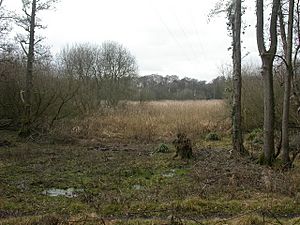Lymington River Reedbeds facts for kids
| Site of Special Scientific Interest | |
 |
|
| Area of Search | Hampshire |
|---|---|
| Interest | Biological |
| Area | 41.7 hectares (103 acres) |
| Notification | 1984 |
| Location map | Magic Map |
The Lymington River Reedbeds is a very important natural area in Lymington, Hampshire, England. It covers about 41.7 hectares, which is roughly the size of 60 football fields! This special place is officially known as a Site of Special Scientific Interest (SSSI) because of its amazing wildlife.
It's also a nature reserve, which means it's protected and looked after by the Hampshire and Isle of Wight Wildlife Trust. This helps make sure that the plants and animals living here stay safe and healthy. The Reedbeds are also part of bigger protected areas called the Solent and Southampton Water Ramsar site and a Special Protection Area. These titles show how important this wetland is for birds and other creatures, not just in the UK but across the world!
Contents
What Makes This Place Special?
The Lymington River Reedbeds are unique because of their history. This area is located in the Lymington River estuary, which is where the river meets the sea. Long ago, this place was affected by the tides, meaning salt water would flow in and out.
How the Reedbeds Were Formed
However, since the 1800s, a special one-way "tide flap" has been used. This flap lets fresh water flow out into the sea but stops salt water from coming back in with the tide. Because of this, the area is no longer salty like the sea. This change has allowed a special type of habitat to grow: freshwater reedbeds.
Important Habitats for Wildlife
The Reedbeds are mostly made up of tall, grassy plants called reeds. Alongside these, there are also areas of natural, untouched grassland. These two types of habitats work together to create a perfect home for many different kinds of animals, especially birds.
Home for Wildlife
The Lymington River Reedbeds are a fantastic place for birds. Many different species come here to breed and raise their young. It's also a vital stop for birds that are migrating, meaning they are flying long distances between their summer and winter homes.
Food for Birds
One of the reasons so many birds love the reedbeds is the food supply. The reeds themselves are home to huge numbers of tiny insects called aphids. These aphids are a great source of food for many birds, helping them to grow strong and healthy.
Protecting Rare Species
Because of its rich environment and abundant food, the Lymington River Reedbeds help protect many bird species. Some of these birds might be rare or endangered in other parts of the country. By keeping this habitat safe, we help ensure these birds have a place to thrive for many years to come.

